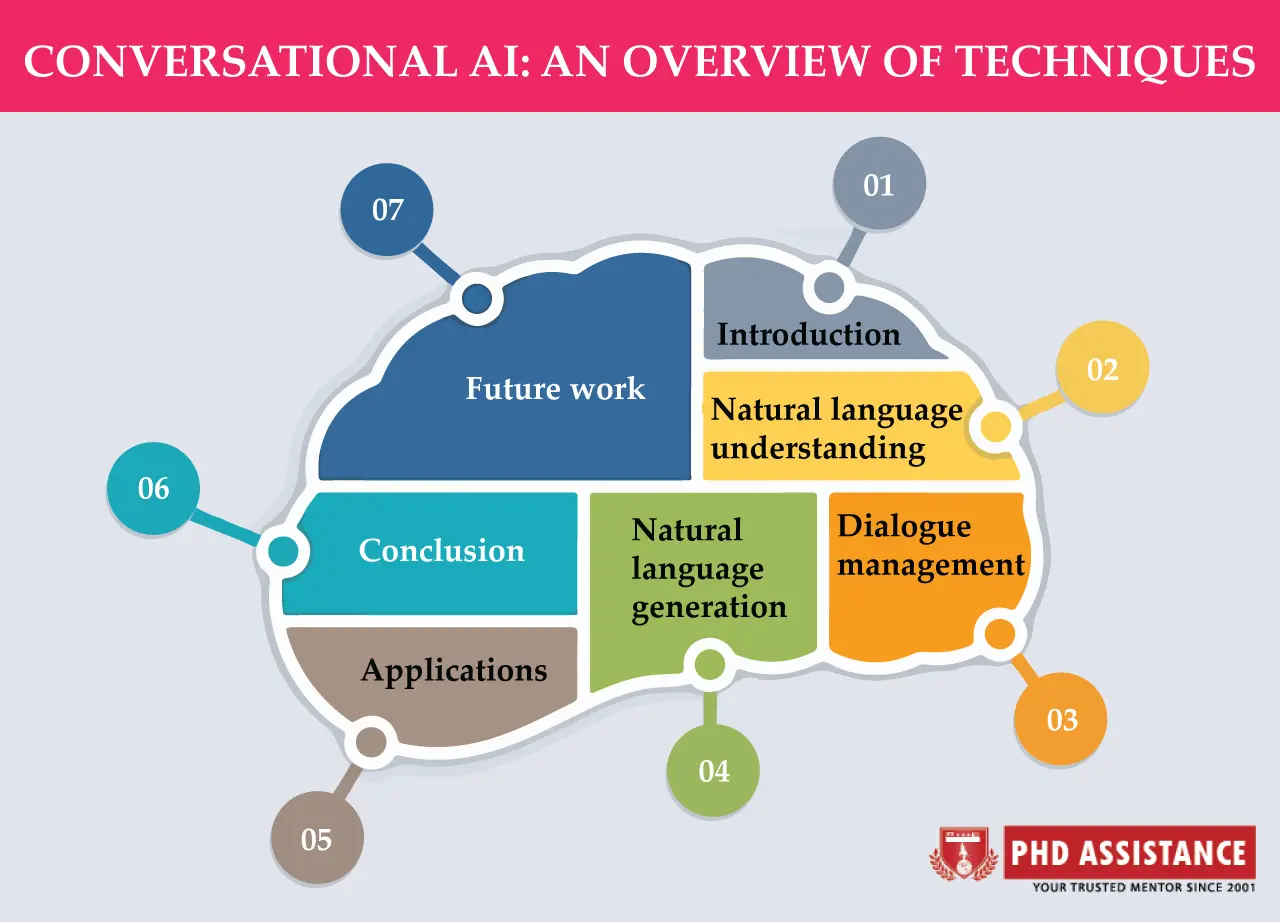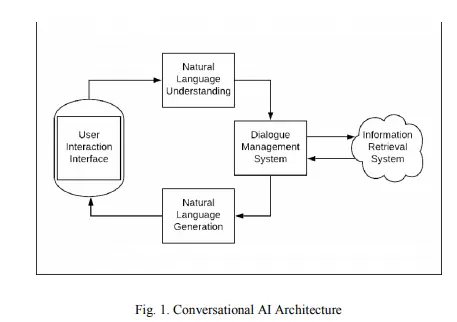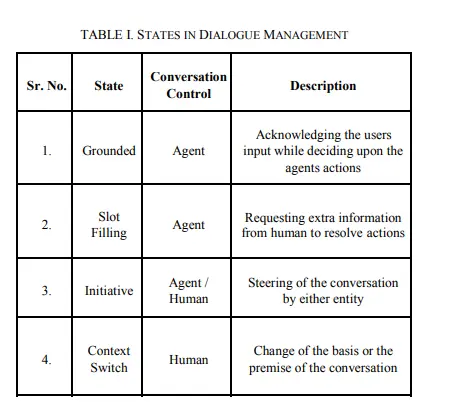CONVERSATIONAL AI: AN OVERVIEW OF TECHNIQUES, APPLICATIONS & FUTURE SCOPE
Conversational AI is a sub-domain of AI that deals with speech-based or text-based AI agents that can imitate and automate conversations and verbal interactions. Due to two major advancements, conversational AI agents such as chatbots and voice assistants have multiplied. On the one hand, the methods required to develop highly accurate AI models, such as Machine Learning and Deep Learning, have advanced significantly as a result of increased research interest in these fields, as well as progress in achieving higher computing power through the use of complex hardware architectures such as GPUs and TPUs. Second, conversational agents have been considered as a natural fit in a wide range of applications such as healthcare, customer service, ecommerce, and education due to their Natural Language interface and the nature of their design.

Introduction.
Conversational AI Agents have become mainstream today due to significant advancements in the methods required to build accurate models, such as machine learning and deep learning, and, secondly, because they are seen as a natural fit in a wide range of domains, such as healthcare, ecommerce, customer service, tourism, and education, that rely heavily on natural language conversations in day-to-day operations. This rapid increase in demand has been matched by an equally rapid rate of research and development, with new products being introduced on a daily basis. The exponential growth in study interest in this topic, on the other hand, has brought to light several interesting, but ephemeral, research prospects. As a result, a systematic record of the key principles of Conversational AI, traditional methodologies and current implementations in these domains, as well as continuing research, is critical. This will serve as a platform for future research and advancements. Conversational AI is made up of three primary components, each of which is subdivided into basic pieces that conduct more preliminary tasks. PhD Assistance experts has experience in handling dissertation and assignment in computer science research with assured 2:1 distinction. Talk to Experts Now
Conveying the current state and results to the other engaging entity is the final step in a Conversational AI engagement. The user should receive the response in an easily understood format. This is accomplished through the usage of Natural Language Generation (NLG). It is the process of transforming structured data into natural language that can be understood by humans. It works in direct opposition to normal language comprehension. Content determination, document structuring, aggregation, lexical choice, referring expression development, and realization are all parts of the process [2].

Each of the aforementioned components is a difficult research challenge in and of itself. To improve the accuracy of each component, various machine learning and deep learning models are applied. This paper examines current research on natural language interpretation, dialogue management, and natural language generation in conversational AI bots, as well as some of the potential future avenues for Conversational AI.
Natural language understanding.
Natural language understanding (NLU) is a field of artificial intelligence (AI) that uses computers to interpret unstructured text or speech as input. Natural language understanding (NLU) is an essential and difficult subset of natural language processing (NLP). NLU is entrusted with conversing with untrained people and deciphering their intentions, which means it interprets meaning rather than just interpreting words. Even common human errors like as mispronunciations or transposed letters or words are not enough for NLU to discern meaning [3]. The NLU allows for direct human-computer communication. The NLU enables computers to understand human languages without the usage of if/else statements. Natural Language Understanding (NLU) addresses one of AI’s most difficult problems [4]. Named Entity Recognition (NER) and Intent Classification are the two fundamental tasks in NLU (IC).
Hire PhD Assistance experts to develop your algorithm and coding implementation for your Computer Science dissertation Services.
Dialogue management.
Dialogue Management (DM) is an important module in the Conversational AI framework that is responsible for regulating the behaviors of the Conversational Agent and translating inputs to appropriate outputs. The DM system is in charge of creating an interaction strategy that will lead the agent in determining its own actions based on the inputs received from the user. Goal/Task Oriented Systems and Non-Task Oriented Systems are the two sorts of DM systems. Object-oriented DM Systems are in charge of moving users from one state of discussion to the next in order to complete a specified or dynamically understood task [7].
When the Conversational Agent is in control of the conversation, the DM system also acts as a state tracker, continuously maintaining the conversation’s state and initiating a transfer from one state to another. Table 1 shows the various situations in which a discussion can be in during a conversation between a human and a Conversational Agent. Some of the classic, current state-of-the-art and promising Dialogue Management System implementation approaches are as follows:

Natural language generation
Natural Language Generation (NLG) is a subdomain of Natural Language Processing that focuses on natural language answer generation methods. NLG is crucial in Conversational AI because it makes the dialogue feel more natural for the human participant, which is a critical component in determining the effectiveness of Conversational Agents. The Dialogue Management system sends structured data to the NLG module, which is based on the dialogue history and present context [8]. As a result, the natural language sentence or text produced by the NLG component in a Conversational Agent is also the final output of the Conversational AI framework for each dialogue occurrence. The NLG component’s output is based on the Natural Language Understanding and Dialogue Management Systems’ processing and outcomes.
Applications
With an expansion in research and development in this domain over the last couple decades, conversational AI applications have proliferated. Conversational Agents are being used in a wide range of applications to execute a variety of activities. Ashay Argal et al developed a chatbot in the tourist industry using DNN (Deep Neural Network) and Restricted Boltzmann Machine (RBM) [9]. Kyungyong Chun et al. created an AI-powered conversational agent that used a cloud-based knowledge base to provide an online healthcare diagnosis service [10].
Conclusion
In order to obtain an understanding of this domain’s evolution, the study offered classic methodologies for Conversational AI implementation. The article on each of the three essential components of Conversational AI Agents, namely Natural Language Understanding, Dialogue Management, and Natural Language Generation, was also reviewed in this article.
Future work
The work given in this paper serves as a springboard for future study in Conversational AI, which can go in a variety of ways. This article has analyzed some of the flaws in current Conversational AI implementations while also presenting some of the current research being complete to address these flaws. This ongoing study can be combined with simultaneous implementations that aid in the general acceptance of these research works while also allowing them to be tested in real-world circumstances. The state-of-the-art works discussed in this paper are the product of a variety of research projects. Future work can be done to combine all of these state-of-the-art component-level works into single hybrid architecture capable of performing extraordinarily well on all Conversational AI tasks, as well as determining the compatibility between these different research works. Finally, as discussed in this article, Conversational AI applications in fields such as healthcare, education, and tourism can be further developed by combining Conversational AI with other AI subdomains such as Computer Vision to investigate tasks such as visual question answering and language-controlled image segmentation.
References
- Qiu, Y. Chen, H. Jia and Z. Zhang, “Query Intent Recognition Based on Multi-Class Features,” in IEEE Access, vol. 6, pp. 52195- 52204, 2018..
- Young, D. Hazarika, S. Poria and E. Cambria, “Recent Trends in Deep Learning Based Natural Language Processing [Review Article],” in IEEE Computational Intelligence Magazine, vol. 13, no. 3, pp. 55-75, Aug. 2018.
- H. Juang and Tsuhan Chen, “The past, present, and future of speech processing,” in IEEE Signal Processing Magazine, vol. 15, no. 3, pp. 2448, May 1998.
- C. Surabhi, “Natural language processing future,” 2013 International Conference on Optical Imaging Sensor and Security (ICOSS), Coimbatore, 2013, pp. 1-3
- Ilievski, V., Musat, C., Hossmann, A., and Baeriswyl, M. (2018). Goaloriented chatbot dialog management bootstrapping with transferlearning.arXiv preprint arXiv:1802.00500.
- Chen, H., Liu, X., Yin, D., & Tang, J. (2017). A Survey on Dialogue Systems. ACM SIGKDD Explorations Newsletter, 19(2), 25–35.
- Hussain, S., Ameri Sianaki, O., & Ababneh, N. (2019). A Survey on Conversational Agents/Chatbots Classification and Design Techniques. Developments in Primatology: Progress and Prospects, 946–956.
- G., Emiel. K., Survey of the State of the Art in Natural Language. Generation: Core tasks, applications and evaluation,Journal of Artificial Intelligence Research 61 (2018) 65-170
- Argal, S. Gupta, A. Modi, P. Pandey, S. Shim and C. Choo,”Intelligent travel chatbot for predictive recommendation in echo platform,” 2018 IEEE 8th Annual Computing and Communication Workshop and Conference (CCWC), Las Vegas, NV, 2018, pp. 176- 183.
- Chung, K., & Park, R. C., Chatbot-based healthcare service with a knowledge base for cloud computing. Cluster Computing. (2018).



